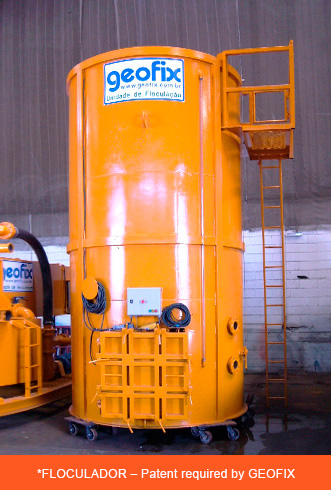ECOLOGY AND ENVIRONMENT

Geofix has been developing execution processes aimed at preserving the environment through the use of cutting-edge equipment with low environmental impact.
Recycling
This procedure consists of treating the bentonite slurry used in the excavation process through the "RECYCLER", in order to separate this mud (water + bentonite) from the materials that make up the local soil (sand / silt / clay), inserted during the excavation process. This process occurs when the mud is thrown into the separation sieves. Then the "clean mud returns to the storage silos (with the characteristics suitable for reuse, according to the technical standard NBR 6122/2010), while recycling material is discarded in dump trucks, similar to material from pile / wall excavation.
This reduces the amount of water used on site, as it significantly increases the reuse of bentonite slurry to be applied.

Flocculation
When bentonite slurry does not reach the minimum conditions prescribed in the technical standards it should be discarded.
To eliminate it, Geofix uses the FLOCULADOR*. With this equipment, after the addition of the flocculant in the bentonite slurry already thrown into its reservoir, separate water and solid residue (bentonite) are obtained.
At the base of the reservoir is deposited the solid bentonite (about 15% by volume) while water remains liquid on the surface (about 85% by volume). After the end of the process, the solid material will be discarded along with the material from the pile / wall excavation and the water will return to a storage silo and be fully reusable.

Concerned about the quality of its services and its responsibility for the environment, Geofix has an internal procedure to assess the emission of black smoke emitted by diesel vehicles.
Geofix builds concrete diaphragm walls for containment and / or foundations. This structure bears loads from neighboring lands and / or the structure, but in addition to these purposes, the Diaphragm Walls can be used as Vertical Hydraulic Barriers, aiming at the remediation of contaminated areas. In certain areas contaminating substances or residues may be found (solvents, fuels, metals, etc.).
Vertical Hydraulic Barriers is an in-situ remediation technique in which waste and / or contaminated soil are confined, preventing contact and subsequent percolation of rainwater, isolating waste from living things and minimizing the presence of groundwater contaminants. Sometimes these barriers can be associated with reactive portions (with charcoal) for treating the contaminated groundwater.
These Hydraulic Barriers are made using a digging technique similar to the execution of Diaphragm Wall. The difference is that the purpose, in this case, is to have contaminated soil containment and not to absorb stresses (thrust and load of the structure). Thus, concrete and steel should be replaced by "coulis", i.e. a mixture of cement, bentonite and water.
The trace of this mixture should be such that it gives very low permeability to this barrier, ensuring a decrease in the concentration of the contaminant outside the confined area. This trace varies depending on the contaminant and the soil to be treated.
WORKS PERFORMED
 Maceió/AL – 1995 - 6200m² of Plastic Diaphragm Wall with 60cm thickness
Maceió/AL – 1995 - 6200m² of Plastic Diaphragm Wall with 60cm thickness
 Camaçari/BA – 2005 – 1800m² of Plastic Diaphragm Wall with 60cm thickness
Camaçari/BA – 2005 – 1800m² of Plastic Diaphragm Wall with 60cm thickness
 Madre de Deus/BA – 2009 – 1000m² of Plastic Diaphragm Wall with 60cm thickness
Madre de Deus/BA – 2009 – 1000m² of Plastic Diaphragm Wall with 60cm thickness
 Maceió/AL – 2014 – 6700m² of Plastic Diaphragm Wall with 60cm thickness
Maceió/AL – 2014 – 6700m² of Plastic Diaphragm Wall with 60cm thickness



